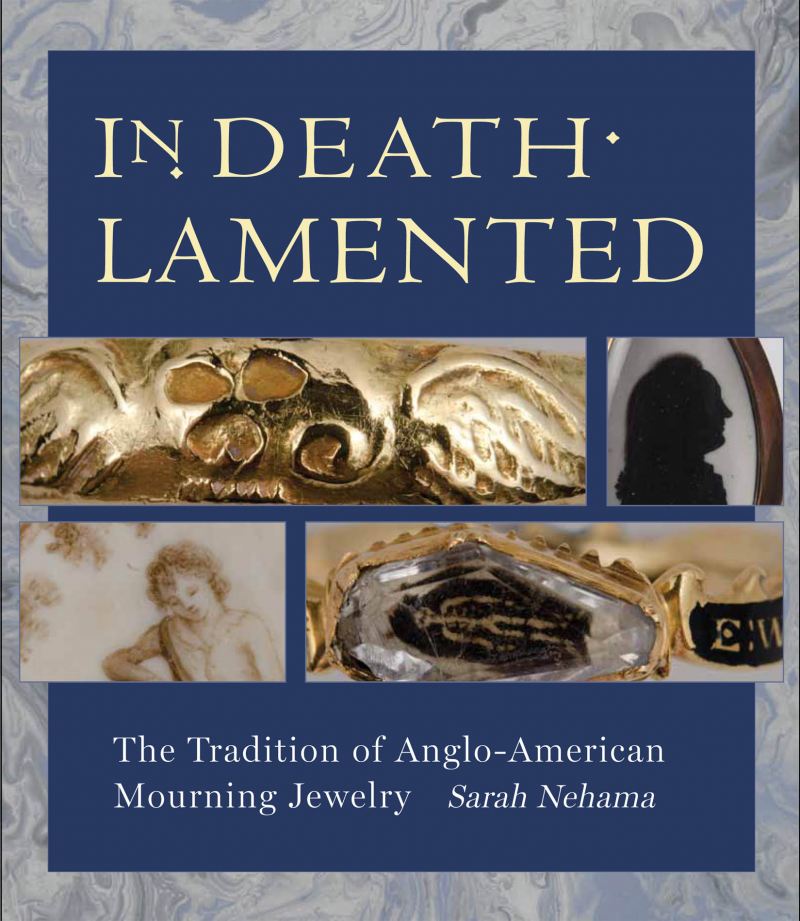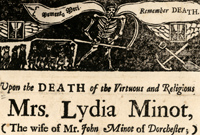
Exhibition: September 2012 to January 2013
In Death Lamented features rings, bracelets, brooches, and other pieces of mourning jewelry from the 17th, 18th, and 19th centuries. Ranging from early gold bands with death’s head iconography to jeweled brooches and intricately woven hairwork pieces of the Civil War era, these elegant and evocative objects are presented in the context of their history, use, and meaning, alongside related pieces of material culture.
The exhibit runs from 28 September 2012 through 31 January 2013, Monday through Saturday, 10:00 AM - 4:00 PM.

Publication
A companion volume developed to accompany the exhibition of the same title, In Death Lamented: The Tradition of Anglo-American Mourning Jewelry, by Sarah Nehama with a foreword by Anne E. Bentley, features 110 full-color illustrations of exemplary pieces of mourning jewelry. The essays and captions provide valuable historical context for the changing styles of mourning ornamentation and the social customs around grieving.

Buy it on Amazon.com
Colonial America & the Revolution
Early mourning jewelry incorporated iconography such as skeletons, gravediggers’s tools, and the winged death’s head. These symbols were related to the memento mori tradition, a Latin phrase meaning "Remember you must die," which exhorted the faithful always to think on death.
 Remembering the dead was not limited to the medium of jewelry, as can be seen in the 1668 broadside commemorating the death of Lydia Minot which includes images of a skeletal figure, an hour glass, a coffin, and a shovel.
Remembering the dead was not limited to the medium of jewelry, as can be seen in the 1668 broadside commemorating the death of Lydia Minot which includes images of a skeletal figure, an hour glass, a coffin, and a shovel.
However, among the jeweled examples below, a skeleton is featured in the ring for John Gray and the winged death's head can be seen on the Eunice Paine ring. The styles in this period range from baroque, to rococo, to neoclassical.
 Charles I locket
Charles I locket
Silver. Box made of leather, silk
 Frances Shirley mourning ring
Frances Shirley mourning ring
Gold, enamel by unidentified goldsmith, 1746
 Eunice Paine mourning ring
Eunice Paine mourning ring
Gold, Thomas Edwards, 1747
 John Crowninshield mourning ring
John Crowninshield mourning ring
Gold, silver, enamel, crystal by an unidentified English goldsmith, finished by Paul Revere, 1761
John Singleton Copley's portrait of Mary (Otis) Gray depicts the woman who is connected to two mourning rings in the collections of the Massachusetts Historical Society. One ring was made in memory of Mary's son, John Gray, who died six days after his birth in September 1763. The other ring commemorates Mary (Otis) Gray herself, who died on 5 November 1763, just months after the death of her son.
 Mary Otis Gray (Mrs. John Gray)
Mary Otis Gray (Mrs. John Gray)
Portrait, oil on canvas by John Singleton Copley, circa 1763
 John Gray mourning ring
John Gray mourning ring
Gold, enamel, crystal, gold foil, hair by unidentified goldsmith
 Mary Otis Gray mourning ring
Mary Otis Gray mourning ring
Gold, amethyst, enamel, crystal by unidentified American goldsmith, 1763
Warning: file_put_contents(/var/www/html/features/juniper/cache/mourning-jewelry^colonial--^var^www^html^^features^bbcms_templates^mourning-jewelry^article^.cache): failed to open stream: Permission denied in /var/www/html/features/juniper/bbcms_class.php on line 268
 Remembering the dead was not limited to the medium of jewelry, as can be seen in the 1668 broadside commemorating the death of Lydia Minot which includes images of a skeletal figure, an hour glass, a coffin, and a shovel.
Remembering the dead was not limited to the medium of jewelry, as can be seen in the 1668 broadside commemorating the death of Lydia Minot which includes images of a skeletal figure, an hour glass, a coffin, and a shovel. John Crowninshield mourning ring
John Crowninshield mourning ring






